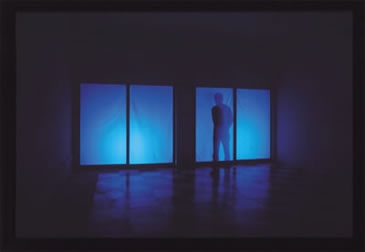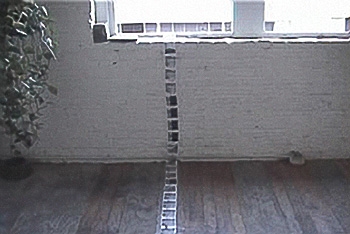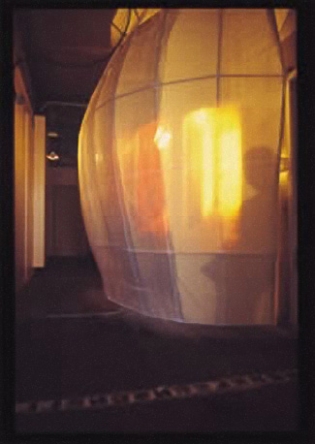Feature: Reviews
Displacement
- 31 Minna Street
- San Francisco
With the wrecking ball poised over the three story warehouse of 31 Minna Street, curators and tenants Eefje Theemus and Alex Homs turned their emptied live/work studio into a one night gallery event to display a show aptly enough entitled Displacement. The theme of eviction is a familiar one, particularly in a town where dot com pressures are forcing artists out one by one and warehouses by the dozen are being torn down or converted into more trendy and profitable establishments. Gathering the work of artists and architects, the show portrayed an enviable energy with installations by some twenty participants, each work portraying the repercussions or metaphorical potential of eviction with varying success.
One of the more intriguing works was a series of low-tech Polaroid photographs by Rommell Taylor attached end to end forming a cinematic ribbon which followed the long singular flight of steps from narrow ground level entry to second floor studio. The images depicted aspects of living, with words alternating: sleep, eat, fuck, work. Once within the space itself, the photos crossed the space, climbed the wall, and eventually jumped out the window to the sidewalk below like some strange suicide; returned to the street, like the studio’s inhabitants.
Eliot Hodges and Maggie Chu encircled the former bathroom with a large off-white curtain spiraling toward the center. The curtain had a translucent quality enhanced by the light projected from within which gave the work an eerie glow. The work inverted the normal privacy of this most intimate and reclusive space with projections from within displayed/displaced onto the exterior of the cubicle. This bathroom was, however, not the only one in the studio which rendered the work metaphorical exercise, not architectural transformation.
Patrick Barnes darkened a large space in the rear of the building to the point of near blackness for his installation, Cendrine. Two windows pulsed with a faint and distant light while an omnipresent sound was somehow amplified by our inability to rely on visuals for understanding. The sound was reminiscent of breathing and produced an overall effect of the building as body, pulsating, alive, and destined for destruction.
Oddly similar to Gary Hill’s 1998 installation at Capp Street Project (23:59:59:29—The Storyteller’s Room), it nonetheless created a defined and powerful mood.
Because much of the work was site specific, (part of the floor cut out and suspended from the ceiling, sheetrock dismembered and layered horizontally between studs, glass rods penetrating a paint chipped wall) the artists were encouraged to leave it as if the show had now become an integral part of the structure. Somewhere in the pile of rubble which once was building, bits and pieces of the work could be discovered before ultimately the entire show was hauled off to the land fill.



